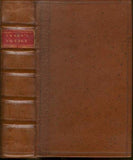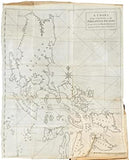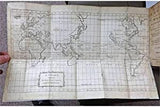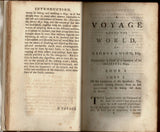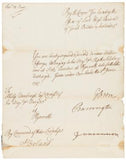A Voyage Round the World in the Years MDCCXL, I, II, III, IV with Official discharge letter signed by George Anson
Author: George Anson (1697-1762) with Official discharge letter signed by George Anson
Year: 1747-1748
Publisher: John and Paul Knapton and Office of the Lord High Admiral
Place: London and Plymouth
Description:
[24]+548 pages with three folding engraved maps present, southern part of South America; part of the Pacific Ocean and the track of the Centurion round the world. Octavo (8 1/4" x 5 1/2") bound in full leather with five raised spine bands with red label to spine in gilt lettering with decorative blind-stamped ruled edges. Compiled from papers and other materials of the Right Honourable George Lord Anson, and published under his direction, by Richard Walter, M.A. Chaplain of his Majesty's Ship the Centurion, in that expedition. Autograph discharge letter signed by Admiral Anson, Barrington and Duncannon (10" x 7¾") (Hill I, pp 317-138). Third edition.
"This is the official account of Anson's voyage. England, at war with Spain in 1739, equipped eight ships under the command of George Anson to harass the Spaniards on the western coast of South America, for the purpose of cutting off Spanish supplies of wealth from the Pacific area. Lord Anson, who was a friend and patron of Benjamin Robins, after returning from the voyage around the world in the Centurion, appears to have entrusted to Robins, for revision, the account of the voyage which had been compiled from the journals by his chaplain, Richard Walter. It is probable that Robins revised and edited the work, wrote an introduction, and added dissertations." (Hill). Perhaps the most popular account of maritime adventure of the eighteenth century. Anson's account of harrying the Spanish of South America, and the taking of the Manilla galleon with treasure with a contemporary value of $800,000, and his circumnavigation has long enjoyed a distinguished place as a masterpiece in descriptive travel.
Document signed by G. Anson, Barrington and Duncannon authorizing the discharge of William Jefferys on HMS Salisbury, a 50-gun fourth rate ship of the line of the Royal Navy active in the war of the Austrian Succession (1740-48) and later in the Seven Years' War (1756-1763).
Aside from the association with Anson and Barrington, the document is significant in that the letter states that William Jefferys "belonging to his Majesty's Ship the Salisbury now at Sick Quarters at Plymouth" is the one to be discharged. It is likely that William Jefferys had been one of several sailors suffering from scurvy aboard the Salisbury. At the time the ship's surgeon was James Lind (1716–1794) who would in 1753 publish the results of his experiments aboard the Salisbury as A Treatise of the Scurvy, and dedicate the book to George Lord Anson, "[w]ho, as a just reward for the great and signal services done to the BRITISH NATION, does now preside over her NAVAL AFFAIRS." While the implications of using citrus for the treatment of scurvy were monumental for the health of the maritime workforce in the age of sail, the experiment is also historically significant in that Lind's clinical trial included control groups. It has been attributed as the first such experiment documented in the history of medicine. At the very least, William Jefferys was a sailor aboard the historic HMS Salisbury, a patient treated by Lind, and quite possibly one of the patients involved in Lind's world-changing experiment.
Between the date this letter was penned on 8 June, 1747 and the date it was received (12 June), George Anson would be elevated to the peerage as Lord Anson, Baron of Soberton, in the County of Southampton (11 June, 1747). Just one year later Anson would publish his narrative Voyage Round the World in the Years MDCCXL, I, II, III, IV. Admiral Barrington would later preside over Captain William Bligh's court martial, and subsequent acquittal, related to the mutiny on HMS Bounty.
From pages 191-196 of Lind's A Treatise of Scurvy,
"The following are the experiments.
On the 20th May, 1747, I took twelve patients in the scurvy onboard the Salisbury at sea. Their cases were as similar as I could have them. They all in general had putrid gums, the spots and lassitude, with weakness of their knees. They lay together in one place, being a proper apartment for the sick in the fore-hold; and had one diet in common to all, viz., water gruel sweetened with sugar in the morning; fresh mutton broth often times for dinner; at other times puddings, boiled biscuit with sugar etc.; and for supper barley, raisins, rice and currants, sago and wine, or the like. Two of these were ordered each a quart of cyder a day. Two others took twenty five gutts of elixir vitriol three times a day upon an empty stomach, using a gargle strongly acidulated with it for their mouths. Two others took two spoonfuls of vinegar three times a day upon an empty stomach, having their gruels and their other food well acidulated with it, as also the gargle for the mouth. Two of the worst patients, with the tendons in the ham rigid (a symptom none the rest had) were put under a course of sea water. Of this they drank half a pint every day and sometimes more or less as it operated by way of gentle physic. Two others had each two oranges and one lemon given them every day. These they eat with greediness at different times upon an empty stomach. They continued but six days under this course, having consumed the quantity that could be spared. The two remaining patients took the bigness of a nutmeg three times a day of an electuray recommended by an hospital surgeon made of garlic, mustard seed, rad. raphan., balsam of Peru and gum myrrh, using for common drink narley water well acidulated with tamarinds, by a decoction of wich, with the addition of cremor tartar, they were gently purged three or four times during the course. The consequence was that the most sudden and visible good effects were perceived from the use of the oranges and lemons; one of those who had taken them being at the end of six days fit four duty. The spots were not indeed at that time quite off his body, nor his gums sound; but without any other medicine than a gargarism or elixir of vitriol he became quite healthy before we came into Plymouth, which was on the 16th June. The other was the best recovered of any in his condition, and being now deemed pretty well was appointed nurse to the rest of the sick…As I shall have occasion elsewhere to take notice of the effects of other medicines in this disease, I shall here only observe that the result of all my experiments was that oranges and lemons were the most effectual remedies for this distemper at sea. I am apt to think oranges preferable to lemons, though it was principally oranges which so speedily and surprisingly recovered Lord Anson's people at the Island of Tinian, of which that noble, brave and experienced commander was so sensible that before he left the island one man was ordered on shore from each mess to lay in a stock of them for their future security. … Perhaps one history more may suffice to put this out of doubt."
Condition:
Some small closed tears at the edges of the maps. Rebound in tooled leather with raised bands. Over all a very good to fine copy. Letter A few minor chips and stains along edges, folds apparent, some creasing, leaf somewhat toned; very good.









